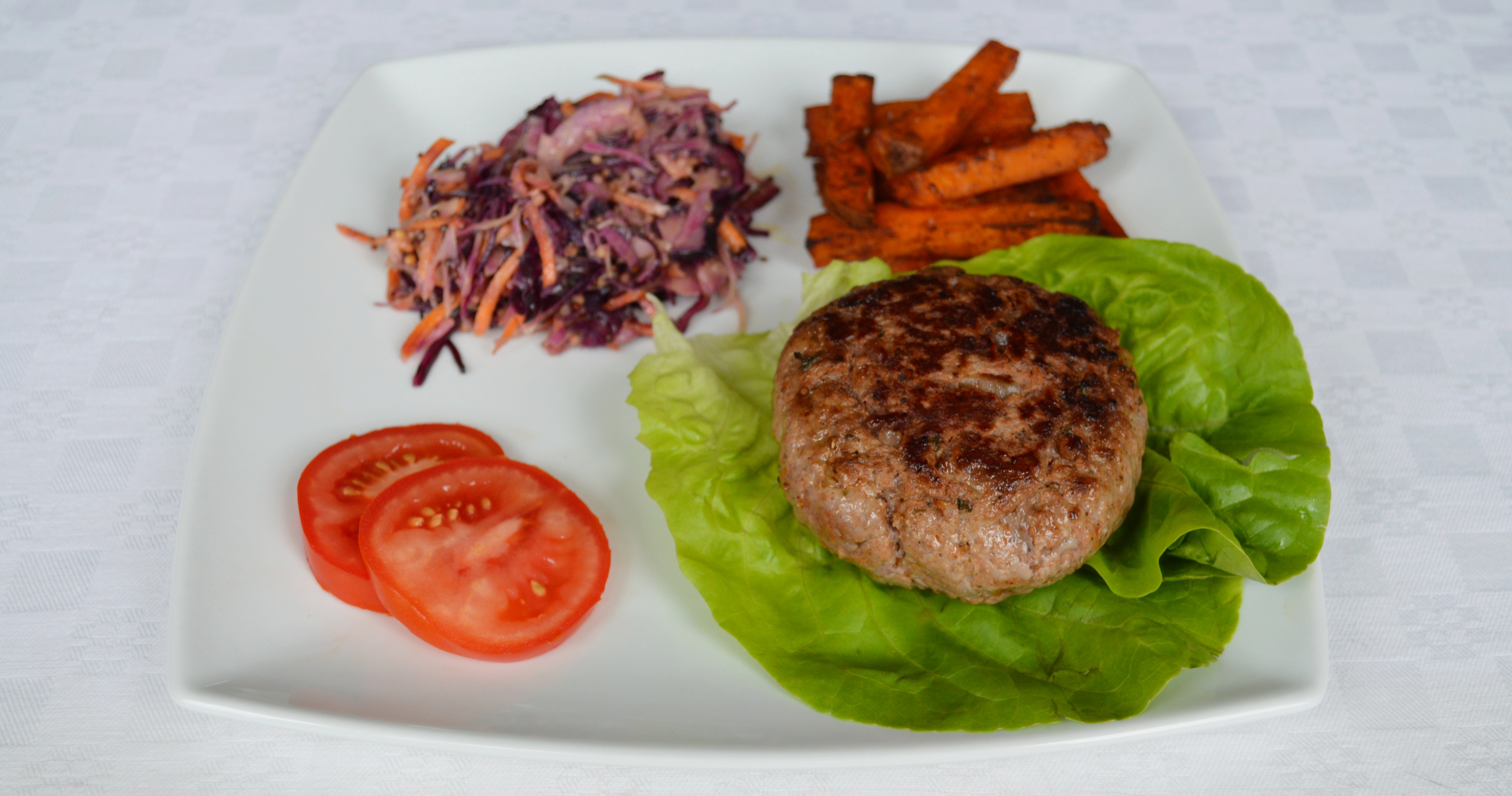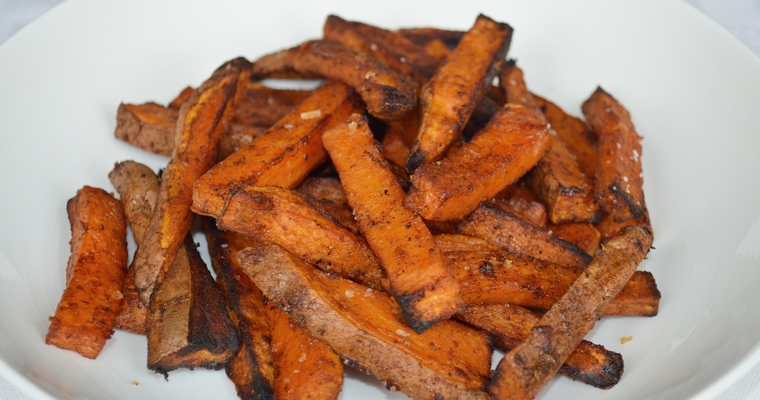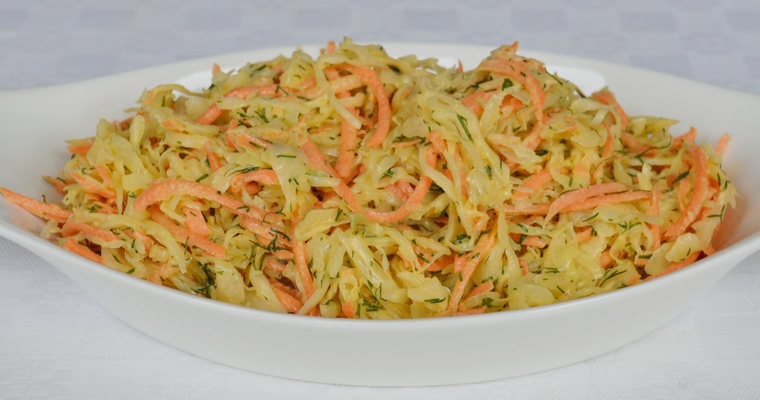Perfectly juicy and pink beef burgers with a tasty brown crust. This Gluten-free and Paleo recipe does not use breadcrumbs – just beef, onion and seasoning.
| Skip straight to the recipe |
01. What are burgers, and how do they differ from meatballs?
Beef burgers are one of the simplest and quickest meat dishes to make. Like their rotund little cousin the meatball, they are made by mixing ground meat with herbs and seasoning, pressing into shape and cooking. But while meatballs are rolled into small walnut-sized balls and cooked slowly in a poaching sauce, burgers are pressed into large flat discs which are cooked quickly in a frying pan or on a grill. As a large surface area of meat is exposed to direct heat, burgers develop a tasty brown crust as the meat sugars caramelise. This means that they have a stronger, meatier flavour than meatballs.
02. What meat should I use to make beef burgers?
Burgers can be made using ground beef, lamb, pork, or even poultry like chicken or turkey. They have the best flavour and texture when a lean meat is used. As they are cooked quickly, they do not need a high fat content to keep the meat moist. In fact, there is not sufficient cooking time for all the fat to render out from a fattier meat like pork. A good lean-to-fat ratio is around 80:20, which is why beef chuck steak is always used in quality burgers. Avoid anything labelled lean beef, as this will result in dry burgers that crumble. Similarly, if you like your burgers cooked well-done, then increase the fat content to 30-40%, as they will be cooked for longer and so lose more moisture.
03. Why do some burger recipes contain breadcrumbs?
If you start with the correct lean-to-fat ratio, then you will have a perfect, juicy burger. But many recipes will still insist on adding breadcrumbs, the purpose of which is to keep the meat tender and moist by absorbing the meat juices that are released during cooking. And if you adulterate burgers with breadcrumbs, then you need to commit another act of adultery by adding a lightly beaten egg to act as a binding agent. This lightens and softens the texture, which some people prefer. To my tastes, a burger is supposed to be meaty and substantial, as that is the whole point of a burger. Where you can legitimately deviate, is in the different seasonings that you add – although light-handedness is generally advisable, as you don’t want to detract from the flavour of the beef. A favourite variation of mine is to add a minced garlic clove, a finely chopped green chilli and 1 tablespoon of tomato purée.
04. How do I cook burgers?
Having selected good ingredients, you are already half way to an amazing burger. You have already ensured a lovely, juicy texture to the pink interior. All you need to do now is ensure a well-developed flavour to the exterior by cooking the patty until the all-important brown crust forms. This is a doddle to achieve using a heavy-based cast iron frying pan, but you may struggle if you are using a non-stick pan, and get better results from using a grill. When it comes to cooking technique, simply let the burger cook in peace. Hold your nerve and wait at least 2 minutes before the first flip, to allow a good crust to form. If you flip too soon, then the cooking side will not have formed a seal and will stick to the bottom of the pan. Do not press down on the patties while frying, as this will expel the juices from the centre, resulting in a dry burger.
Tips & Tricks
- Chop ingredients very finely (or grate or puree) – coarse ingredients result in crumbly burgers that fall apart
- Mix by hand – food processors are too aggressive and ruin the texture of ground meat
- After forming patties, refrigerate for at least 30 minutes – this firms up the texture
- When frying, heat the pan to sizzling point – this creates an instant seal when the meat is added, preventing it from sticking and keeping the moisture locked in
- Do not turn for the first two minutes, until the the cooking side has formed a seal – otherwise the bottom will stick to the pan and break apart
- Do not press down on the patties while frying – this will release the meat juices that keep the beefburger moist
- Leave to rest – this gives the muscle fibres time to relax and reabsorb the meat juices that get driven out during cooking. Otherwise the meat juices will run out and be lost when the meat is cut, resulting in tough, dry meat
Ingredients
- 1/2 onion, peeled and very finely chopped
- 2 tablespoons cooking oil (I used lard)
- 700g chuck steak mince (or non-lean mince)
- 1 tablespoon finely chopped parsley leaves
- 1 tablespoon Dijon mustard
- 1 teaspoon salt
- 1 teaspoon freshly ground black pepper
Instructions
- Saute the onion. Heat 1 tablespoon of the cooking oil in a large, heavy-based frying pan over a medium heat. Add the onion and fry for about 4 minutes, until translucent but not brown. Turn off the heat and leave to cool to room temperature.
- Make the burgers. Combine all the burger ingredients in a large mixing bowl. Use your hands to crumble up the mince and work the seasoning into the mince. Avoid using a food processor to do this, as this will grind the mixture too finely, resulting in a slimy texture.
- Divide the mixture into 4 equal-sized balls. Pat and mould into patties. Place on a tray, then transfer to the refrigerator for at least 30 minutes to firm up.
- Cook the burgers. Wipe out the pan with kitchen paper, then heat the rest of the cooking oil over a medium-high heat. When a few drops of water sizzle and evaporate upon contact with the pan, add the burgers. For a rare burger, fry the patties for 4 minutes each side. If you prefer a well done burger, then fry 7 minutes a side (or simply make flatter, thinner patties that will cook quicker). Do not turn during the first 2 minutes of frying, and do not press down on the patties.
- When done, remove from the pan and leave to rest for 5 minutes, covered by a double layer of tin foil.
- Transfer to a plate and serve the beef burger on top of a lettuce leave to absorb any grease, and use as a gluten-free bun.





Hi, can these be frozen before cooking? Any tips?
Hi Mel, yes, these can be frozen. When packaging for the freezer, intersperse each patty with a square of wax-coated freezer paper to stop them from fusing together (this will speed up defrosting). Next, make an airtight packaging by wrapping tightly in a double layer of plastic food wrap, and then wrap the whole lot in a freezer bag secured with tape. This will stop air from circulating and causing freezer burn. Burgers are best kept in the freezer for no more than 4 months.
For more information, read the meat section in my article How to Freeze Food.